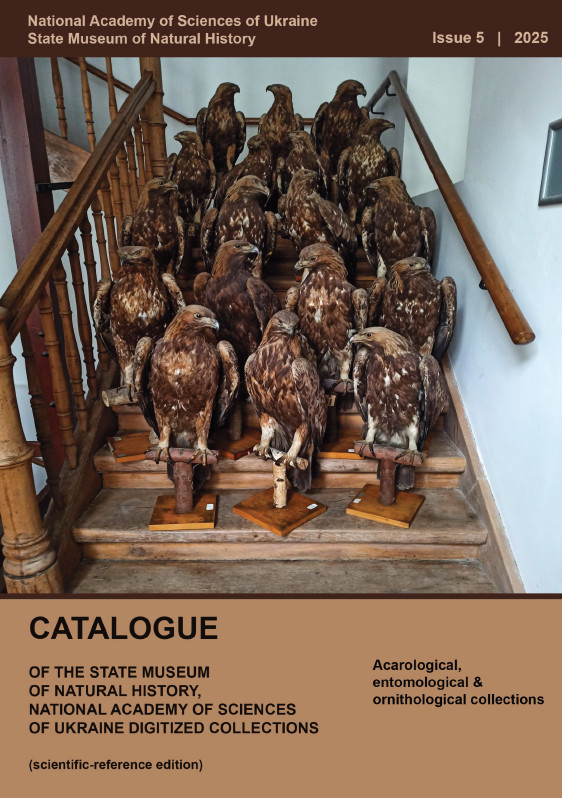Catalogue of specimens of the Camisia Heyden, 1826) (Oribatida, Crotoniidae) deposited in the State Museum of Natural History NASU, Lviv, Ukraine // Catalogue of the digitized collections, deposited in the State Museum of Natural History, National Academy of Sciences of Ukraine. Issue 5. Acarological, entomological & ornithological collections. – Lviv, 2025. – P.6-16.
DOI:
Key words: Camisia, Oribatida, Crotoniidae, collection, State Museum of Natural History NASU
The global fauna of Crotoniidae Thorell, 1876 comprises 169 species distributed across five genera (Subias, 2004). The Crotonioidea superfamily has a cosmopolitan distribution and is well-represented in various terrestrial habitats (Krant et al., 2009). Notogaster is frequently found with organic or mineral remains attached (Subias & Shtanchaeva, 2023). Their bodies are typically holoid. Most species within Crotonioidea reproduce via parthenogenesis. The Crotoniidae family is primarily found in the Southern Hemisphere (Krant et al., 2009). Molecular analyses suggest that the Crotoniidae originated from within the Camisiidae family and that sexual reproduction re-evolved in this lineage (Domes et al., 2007). The genus Camisia Heyden, 1826 is represented by 34 species and 1 subspecies worldwide (Subias, 2004). Species of Camisia are mainly arboreal, inhabiting tree trunks, the canopy, or living among mosses and lichens on rocky surfaces. (Trave 1963). Weakly pigmented, large mites (more than 1 mm). The cuticle secretes a fluid that mixes with sand grains and sticks between the setae. Bothridial setae are short, with a distal widened head. Prodorsum and notogaster with chitinized outgrowths on which the setae sit. There are 9 pairs of genital setae, 2 pairs of aggenital, 3 pairs of anal and adanal. The aggenitals begin on the soft surface of the body, between the aggenital and anal plates. Legs are usually 3-clawed, less often 1-clawed (Sergienko, 1994). This work continues the series of publications related to the digitization of the collection of oribatid mites of the State Museum of Natural History of the NAS of Ukraine (Hushtan K., Hushtan H., 2024; Novikov et al., 2024; Rukavets, Hushtan, 2021). There are 6 species of the Camisia genus known from Ukraine, namely: Camisia biurus (Koch, 1839), C. lapponica (Trägårdh, 1910), C. spinifer (Koch, 1835), C. biverrucata (Koch, 1839), C. horrida (Hermann, 1804), C. segnis (Hermann, 1804) (Ярошенко, 2000, Melamud, 2003, 2008; Chernobai et al., 2003). The collection of oribatid mites of the State Museum of Natural History of the NAS of Ukraine includes the specimens, belonging to 4 species of Camisia: C. biurus (Koch, 1839), C. lapponica (Trägårdh, 1910), C. spinifer (Koch, 1835), C. biverrucata (Koch, 1839). The oribatids were collected by Melamud V.V., Rizun V.B., Kaprus I.Ya., Tur R.F. They are represented by 65 individuals collected in the west of Ukraine, what makes up 17 records. In particular, the collection has samples collected from Zakarpatska, Lvivska and Ivano-Frankivska provinces. Some of the presented materials were collected in the territories of the Carpathian Biosphere Reserve, the Nature Reserve «Roztochchia», the National Nature Parks Carpathian and Verkhovynskyi and the Landscape Reserve «Grofa».
References
1. Рукавець Є.В., Гуштан Г.Г. 2021. Кліщі-нотріди (Acari: Oribatida:
Nothridae) у колекції Державного природознавчого музею НАН України.
Наукові записки Державного природознавчого музею. Вип. 37. С.57-62. DOI:
https://doi.org/10.36885/nzdpm.2021.37.57-62
2. Ярошенко Н.Н. 2000. Орибатидные клещи (Acariformes, Oribatei)
естественных экосистем Украины. Донецк: ДонНУ. 312 с.
3. Hushtan K., Hushtan H. 2024. Catalogue of Bracychthoniidae
(Sarcoptiformes, Oribatida) specimens deposited in the State Museum of
Natural History NASU, Lviv, Ukraine. Catalogue of the digitized
collections, deposited in the State Museum of Natural History, National
Academy of Sciences of Ukraine. Issue 2. Herbarium, acarological &
entomological collections. Lviv. P.31-40. [Electronic publication]. DOI:
https://doi.org/10.36885/cdcsmnh.2024.23
4. Domes K., Norton R.A., Maraun M., Scheu S. 2007. Reevolution of
sexuality breaks Dollo's law. Proceedings of the National Academy of
Sciences. 104. P.7139-44.
5. Chernobai Yu.N., Kaprus’ I.Ya., Rizun V.B., Melamud V.V. et al. 2003.
Oribatid mites (Acariformes, Oribatei). [In Russian]. Ekologiya i fauna
pochvennykh bespozvonochnykh Zapadnogo Volyno-Podol’ya: (Ecologiya and
fauna of invertebrata soil of the West Volyno-Podol’ya). Naukova dumka.
Kiev. P.70-100.
6. Krant G.W., Walter D.E., Behan-Pelletier V. et al. 2009. A manual of
acarology. Lubbock: Texas Tech University Press. 807 p.
7. Melamud V.V. 2003. Oribatid mites of Ukrainian Carpathians. [In
Russian, English summary]. Pancyrnye kleshchi Ukrainskikh Karpat. L’vov.
151 p.
8. Melamud V.V. 2008. Cataloge of oribatid mites (Acari: Oribatida) of
the Transcarpathian region І. Scientific Bulletin of Uzhhorod
University. Series Biology. 23 P.198-208.
9. Norton R.A., Palmer S.C. 1991. The distribution, mechanisms and
evolutionary significance of parthenogenesis in oribatid mites. In
Schuster and Murphy. The Acari. P.107-136.
10. Novikov A., Rizun V., Susulovsky A., Hushtan H., Hushtan K.,
Kuzyarin O., Savytska A., Nachychko V., Susulovska S., Leleka D. 2024.
Data mobilisation at the Fund of Invertebrates of the State Museum of
Natural History of the NAS of Ukraine. Biodiversity Data Journal 12:
e131188. https://doi.org/10.3897/BDJ.12.e131188
11. Sergienko G.D. 1994. Archoribatida – Lower oribatids. In:
Topachevsky (ed.): Fauna of the Ukraine 25. Kiev: Naukova Dumka.
P.5-204. [in Russian].
12. Subías L.S. 2004. Listado sistemático, sinonímico y biogeográfco de
los ácaros oribáti dos (Acariformes: Oribatida) del mundo (excepto
fósiles) (19ª actualización). Graellsia, 60 (número extraordinario):
545. Available online at: http://bba.bioucm.es/cont/docs/RO_1.pdf
[Accessed on January 2024].
13. Subias L.S., Shtanchaeva U. Ya. 2023. Claves de familias, géneros y
subgéneros de ácaros oribátidos del mundo (Acari, Oribatida).
Monografías electrónicas Sociedad Entomológica Aragonesa. 13. 290 p.
http://sea-entomologia.org/MeSEA13_2023.pdf
14. Trave J. 1963. Ecologie et biologie des Oribates (Acariens)
saxicoles et arboricoles. Vie Milieu. Suppl.14. P.1-267.
15. Weigmann G. 2006. Hornmilben (Oribatida): Acari, Actinochaetida.
Goecke & Evers, Keltern. 520 p.




